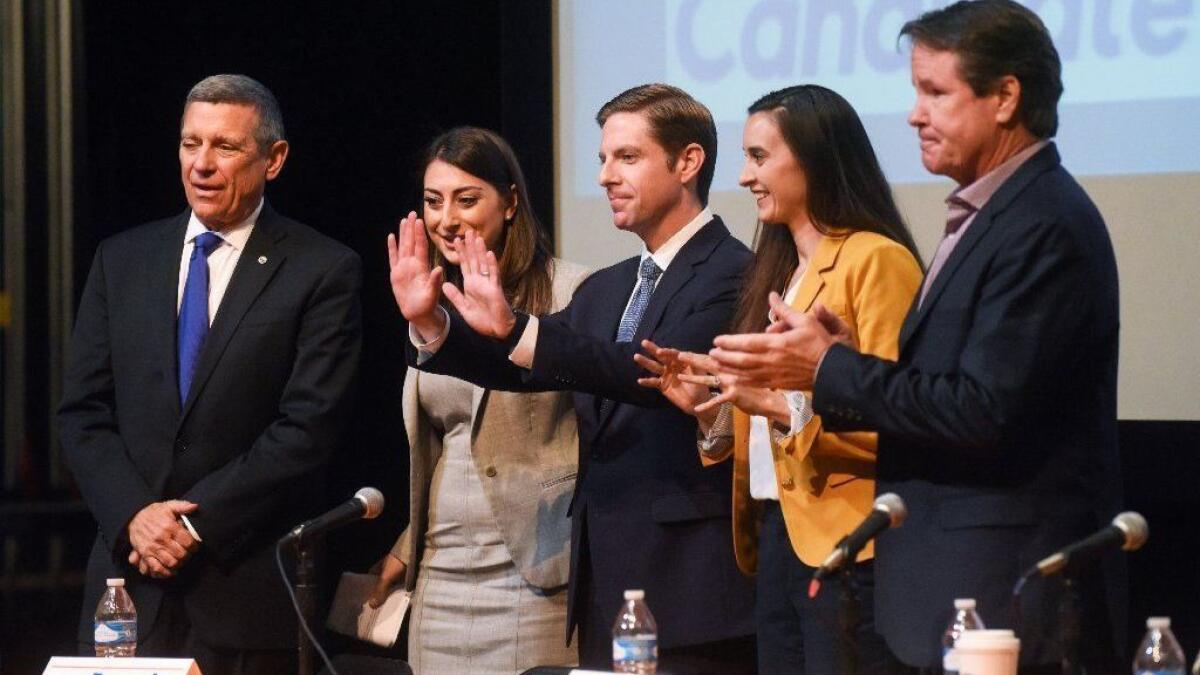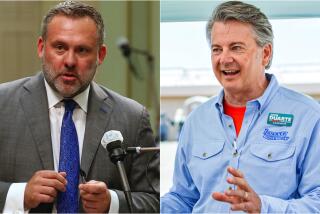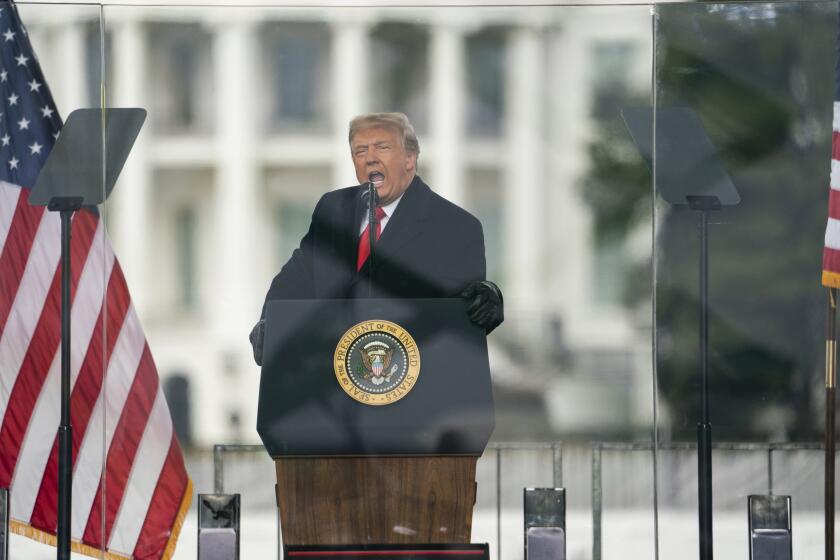Spending soars in California’s crowded congressional races ahead of Tuesday primary

California’s competitive crowded House races are getting pricey — more than $108 million has been spent so far this cycle to help elect candidates to Congress, double what was spent in the last primary election cycle.
The eye-popping figures are thanks, in part, to the state’s complex top-two primary election system. With a number of seats up for grabs while Democrats are hoping to wrest control of the U.S. House, the races have been combative and expensive.
Total spending to support or oppose candidates — money spent by either the candidates themselves or outside interest groups — in California House races dwarfs the $58 million tallied at roughly this point in the 2016 election cycle. About $150 million was spent trying to influence voters during the entire 2016 cycle in California.
The candidates are spending money on everything, including television commercials, mailers and consultants. One Orange County Democrat, Andy Thorburn, has spent a cool $1.4 million on the firm overseeing his electoral strategy.
Why is 2018 so much more expensive than the last election?
More political actors — wealthy candidates, committees, parties — are spending more money earlier than they have in previous cycles, largely in an effort to game the system, which advances the two highest vote getters to the general election regardless of their party.
More simply put, candidates must spend money now if they want to emerge from the morass to fight on into November.
A large pool of Democratic candidates, many capable of pouring their own wealth into their campaigns, is making an impact, said Rob Pyers, research director for the nonpartisan California Target Book, which follows races in the state.
“I think the big takeaway is that recruiting outsider candidates capable of self-funding is a double-edged sword,” Pyers said. “The [Democratic Congressional Campaign Committee] sought out a number of these candidates so the national organization wouldn’t have to shoulder any of the heavy lifting. Once the process spiraled out of their control, though, the arsenal of tools that could be used to shape the field had been whittled away to some stern words and empty threats, and they’ve found themselves becoming a victim of their own success.”
Democrats view multiple races as competitive, but are focusing efforts on the seven House seats currently held by Republicans but won by Hillary Clinton in the 2016 presidential election. Those districts are in suburban Orange County and San Diego, the Central Valley and northern Los Angeles County. Two are open-seat races thanks to GOP Reps. Ed Royce and Darrell Issa retiring.
Everything you need to know about the June 5 primary »
Democratic enthusiasm in those districts has drawn out a plethora of candidates who have been able to capitalize on anti-Trump sentiment to raise funds. Republican incumbents also began to raise money at a healthy clip as the primary challengers multiplied.
The interest in politics and opposition to Trump also have drawn out wealthy first-time candidates who are throwing down seven-figure amounts in hopes of capturing one of the two spots in the primary.
The crowded race to replace Issa (R-Vista) in California’s 49th Congressional District has drawn out a pair of self-funding millionaires.
Businessman Paul Kerr gave his campaign $4.1 million while Sara Jacobs, granddaughter of Qualcomm cofounder Irwin Jacobs, has financed to the tune of $1.5 million, according to the nonprofit Center for Responsive Politics.
In a neighboring Orange County’s 39th Congressional District, lottery winner Gil Cisneros has given his campaign about $3.5 million while healthcare executive Andy Thorburn has pitched in $2.7 million of his own money.
Total spending in each of those districts exceeds $16 million.
Helping push up the total are independent expenditures by outside groups like the Democratic Congressional Campaign Committee and the Democratic House Majority PAC as well as special interest groups like the Emily’s List-affiliated group Women Vote.
Over $16 million in independent expenditures have been reported so far this cycle — more than five times the $2.9 million spent at this point in the 2016 cycle. During that cycle Democratic groups spent early to make sure that the anointed Democrat in a Santa Barbara county race — local county Supervisor Salud Carbajal — made it out of a crowded primary field in his effort to replace retiring Rep. Lois Capps.
That race also saw spending by an outside conservative group nonprofit organization working to promote another Democrat, looking to siphon off votes from Carbajal. Carbajal ultimately won 31.9% of the vote while Republican Justin Fareed claimed 20.5%. Carbajal went on to win the seat in the general election.
Two years later the DCCC and other groups find themselves deeper in the murky waters of the top-two primary trying to master the right alchemy that gets a candidate into the November race.
In one Orange County district, the DCCC has spent about $110,000 to promote little-known Republican John Gabbard. If his name identification goes up thanks to the spending, it is possible he can take votes from Rep. Dana Rohrabacher and former Orange County Republican Party Chairman Scott Baugh.
Should Republican votes split, the DCCC’s preferred Democrat, Harley Rouda, could rise and make it to November.
The same thinking is at play in the 39th District, where Democrats are spending on television ads that go after two Republicans running for Royce’s seat. The ads made no mention of a third Republican, Young Kim, who has led polls and has the backing of Royce. She is widely seen as the Democrats’ most formidable potential opponent in November — should one of them make it on the ballot.
Track the congressional races that will make the difference in California »
Twitter: @jpanzar
More to Read
Get the L.A. Times Politics newsletter
Deeply reported insights into legislation, politics and policy from Sacramento, Washington and beyond. In your inbox three times per week.
You may occasionally receive promotional content from the Los Angeles Times.











